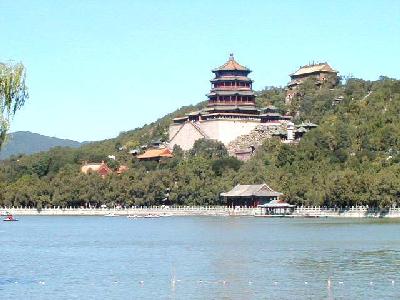Summer Palace in Beijing
The Summer Palace is situated in western outskirts of Beijing and is 10 kilometers from the central city. It is world famous and the leading classical garden in China.
The Summer Palace was first built in 1153 and served as an imperial palace for short stays away from the capital. It was rebuilt in 1888 by the Empress Dowager Ci Xi who spent an enormous amount of money on it from funds that had been appropriated to build a Chinese navy.
The two main elements of the garden are Longevity Hill and Kunming Lake. Kunming Lake takes up three quarters of the garden′s 290 hectares and there is an exquisite building in the middle of it. The garden is divided into three parts: a political activity area with the Hall of Benevolence and Longevity as its center; the living quarters of the empress with the hall of Jade Ripples and the Hall of Happiness and Longevity at the center, and a scenic area featuring Longevity Hill and the Kunming Lake. The groups of buildings, hills and lakes, together with the background of West Hills, give an ever changing scene.
 The buildings on the southern slope of Longevity Hill are characteristic of the garden. Cloud-Dispelling Hall, the Pavilion of the Fragrance of Buddha and the Wisdom Sea on the axis line are flanked by the Wheel Hall, Wufang Pavilion and Baoyun Pavilion and are major attractions. The Pavilion of the Fragrance of Buddha is 41 meters high and stands on a 20-meter-high terrace. At the foot of Longevity Hill is the 728-meter-long passageway, which links the three areas together. The passageway is famous for its paintings and at its western end is a 36-meter-long Marble Boat.
The buildings on the southern slope of Longevity Hill are characteristic of the garden. Cloud-Dispelling Hall, the Pavilion of the Fragrance of Buddha and the Wisdom Sea on the axis line are flanked by the Wheel Hall, Wufang Pavilion and Baoyun Pavilion and are major attractions. The Pavilion of the Fragrance of Buddha is 41 meters high and stands on a 20-meter-high terrace. At the foot of Longevity Hill is the 728-meter-long passageway, which links the three areas together. The passageway is famous for its paintings and at its western end is a 36-meter-long Marble Boat.
The bridges of the western causeway of Kunming Lake are replicas of the bridges of famous Su and Bai causeways on West Lake in Hangzhou. The marble Seventeen-Arch Bridge, which spans the Eastern Causeway to South Lake Island has balusters topped by 540 carved lions, each in a different pose.
Back Lake at the northern foot of Longevity Hill is natural and peaceful. On its bank is Suzhou Street, a replica of a commercial street in the old days. At the northeastern corner of the garden there is the Ganden of Harmonious Interest, which imitates the famous Jichang Garden in Wuxi, Jiangsu Province. Diminutive and elegant, it is known as a garden within a garden.
The Summer Palace was opened to the public in 1924 and it takes one day to view it in detail. Public buses go to the outskirts or a special sightseeing coach can take you there.
Included in the UNESCO world heritage list in 1998.
Source: http://old.cnta.gov.cn